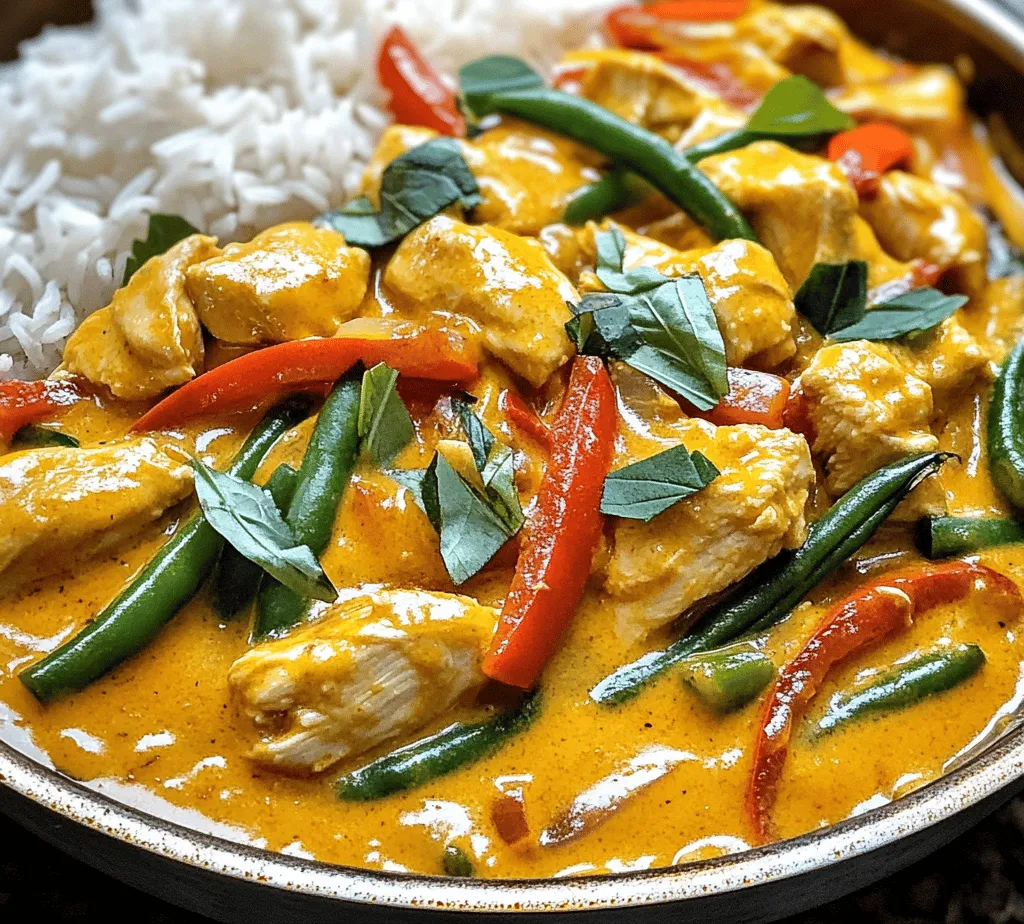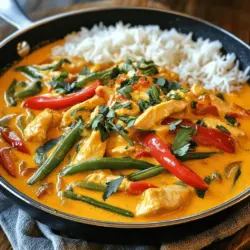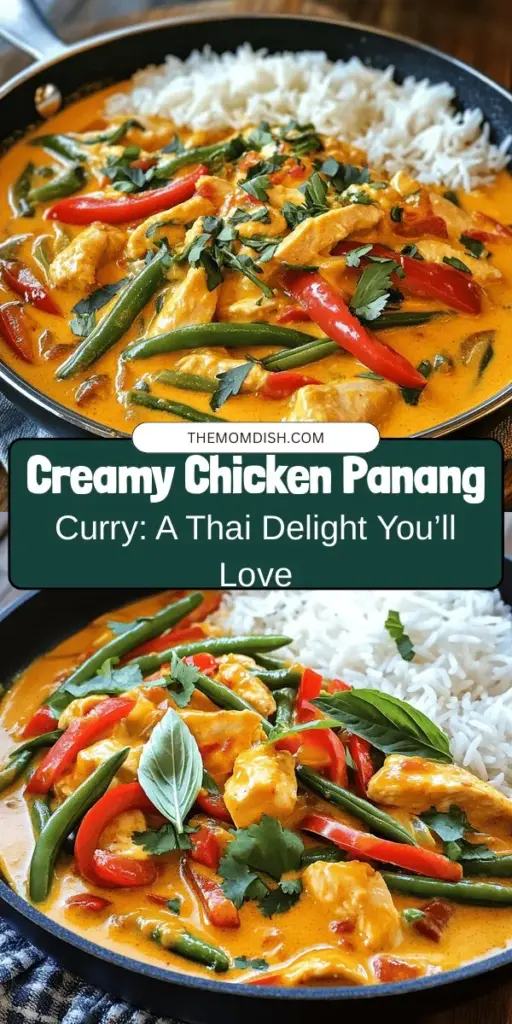Introduction
Panang curry is one of the most beloved dishes in Thai cuisine, renowned for its rich and creamy texture combined with a complex blend of flavors. This curry is not just a meal; it’s an experience that transports you to the bustling street markets of Thailand, filled with the aroma of spices and the vibrant colors of fresh ingredients. The uniqueness of Panang curry lies in its ability to balance sweet, savory, and spicy notes, making it a favorite among curry aficionados.
The significance of Panang curry in Thai culture cannot be overstated. It’s often served on special occasions and is a staple at family gatherings, showcasing the communal aspect of dining in Thai traditions. Its versatility allows for a variety of proteins and vegetables, making it easy to customize based on personal preferences or dietary restrictions. Whether you’re a seasoned cook or a culinary novice, the preparation of this dish is straightforward, allowing anyone to create a flavorful meal that impresses.
Understanding Panang Curry
Panang curry, also spelled as “Penang” or “Panaeng,” originates from the southern region of Thailand, specifically from the island of Penang. The name itself reflects its roots, and while it shares some characteristics with other Thai curries, it possesses distinctive traits that set it apart. Unlike the more liquidy green or red curries, Panang is thicker and creamier due to the generous use of coconut milk and the specific blend of spices in the curry paste.
What truly differentiates Panang curry from other types of Thai curries is its unique flavor profile. It is characterized by a slightly sweet and nutty taste, infused with the richness of coconut milk and the aromatic depth of herbs and spices. Authentic Panang curry paste typically includes ingredients such as dried red chilies, garlic, shallots, lemongrass, galangal, and kaffir lime leaves, all blended together to create a smooth, aromatic paste. This paste is the heart of the curry, providing the essential flavor that defines the dish.
Key Ingredients for Rich & Creamy Chicken Panang Curry
To prepare a delicious Chicken Panang curry, a few key ingredients are essential. The star of the dish is, of course, chicken, which provides a hearty base for the rich sauce. Chicken thighs are commonly used due to their tenderness and ability to retain moisture during cooking, but chicken breast can also be substituted for a leaner option.
Coconut milk is another critical component, contributing to the curry’s creamy texture and balancing the heat from the spices. The quality of the coconut milk can significantly affect the final dish, so using a high-quality brand or freshly made coconut milk is recommended.
The third crucial ingredient is Panang curry paste. While store-bought versions are widely available, making your own can elevate the dish to another level, allowing for a fresher taste and customized spice level. Fresh herbs and vegetables, such as bell peppers, basil, and lime leaves, are also vital in enhancing the flavor and adding brightness to the curry.
For those with dietary preferences or restrictions, this recipe offers flexibility. You can easily substitute chicken with tofu or vegetables for a vegan or vegetarian option. Additionally, using low-fat coconut milk can reduce calories while still providing a satisfying creamy texture.
Preparation Steps: A Detailed Guide
Preparing the Ingredients
Before diving into the cooking process, proper preparation of the ingredients is crucial for a successful Panang curry. Begin by gathering all the necessary ingredients to streamline the cooking process. This not only saves time but also ensures that you have everything on hand when needed.
1. Chicken: Cut the chicken into bite-sized pieces, ensuring uniformity for even cooking. If using chicken thighs, trim any excess fat for a cleaner presentation.
2. Vegetables: Chop your choice of vegetables, such as red bell peppers, green beans, or zucchini. Aim for similar sizes to ensure they cook evenly.
3. Herbs and Aromatics: Mince garlic and shallots finely to release their flavors. If using fresh lemongrass, finely chop the tender parts, and tear the kaffir lime leaves into smaller pieces to maximize their aromatic contribution.
4. Curry Paste: If making homemade Panang curry paste, blend all the ingredients until smooth. If using store-bought, have it ready in a small bowl for easy access during cooking.
Efficient organization of ingredients will not only make the cooking process smoother but will also enhance the flavors as everything comes together seamlessly.
Heating the Oil
Once your ingredients are prepped, it’s time to heat the oil in a large skillet or wok over medium heat. The type of oil you choose can influence the overall flavor of the dish. Traditionally, vegetable oil is used, but you can also opt for coconut oil for an extra touch of tropical flavor.
The oil serves multiple purposes in this step. Firstly, it provides the necessary heat for cooking the chicken and aromatics. Secondly, it helps to develop the flavors by allowing the spices and curry paste to bloom. When the oil is hot, you should see a shimmer on the surface, indicating it’s ready for the next step.
Cooking the Chicken
With the oil heated, add the chicken pieces to the pan. Ensure not to overcrowd the pan, as this can lead to steaming rather than browning. If necessary, cook the chicken in batches to achieve a nice golden color on each piece.
For optimal browning, let the chicken sit undisturbed for a few minutes before stirring. This allows for the Maillard reaction to occur, creating a savory crust that enhances the flavor of the dish. Once the chicken is browned on all sides, it’s essential to ensure it is cooked through. The internal temperature should reach at least 165°F (75°C) for safety and to ensure the best taste.
Adding the Curry Paste
After the chicken is perfectly browned, it’s time to add the Panang curry paste. Stir the paste into the chicken, allowing it to coat the meat evenly. Cooking the curry paste is a crucial step, as it helps release the essential oils and flavors from the spices, elevating the overall taste of the curry.
You’ll know the paste is ready for the next step when it becomes fragrant and slightly darkens in color, typically taking about 1-2 minutes. This step not only enhances the flavor but also prevents the raw taste of uncooked spices from permeating the dish.
Incorporating Coconut Milk
The final step in this preparation stage is to incorporate the coconut milk. Pour the coconut milk into the pan, stirring gently to combine it with the chicken and curry paste. The coconut milk will create a luscious, creamy sauce that envelopes the chicken and vegetables.
As the mixture begins to simmer, the flavors will meld together beautifully. At this stage, you can adjust the consistency of the curry by adding more coconut milk or a splash of chicken broth, depending on your preference for thickness. If desired, you can also add a splash of fish sauce or soy sauce for an added umami kick.
This detailed preparation sets the stage for a delicious and aromatic Chicken Panang curry that will tantalize your taste buds and impress anyone fortunate enough to share your meal. Stay tuned for the next part, where we will explore the finishing touches and serving suggestions that make this dish a complete experience.

Benefits of Using Coconut Milk in the Dish
Coconut milk is a key ingredient in Chicken Panang Curry, contributing to its signature richness and creaminess. Not only does it add a velvety texture, but it also balances the spices and heat from the curry paste. Coconut milk is a source of healthy fats, particularly medium-chain triglycerides (MCTs), which can provide quick energy and support weight loss. Additionally, it contains essential vitamins and minerals such as potassium and magnesium, aiding in various bodily functions.
The creamy consistency of coconut milk also helps to create a luscious sauce that clings beautifully to the chicken and any vegetables you may choose to add. This makes each bite a delightful experience, enhancing the overall enjoyment of the dish.
Tips for Achieving the Right Consistency and Flavor
Achieving the perfect consistency and flavor in your Chicken Panang Curry requires attention to detail. Here are some tips to help you perfect your dish:
1. Use Full-Fat Coconut Milk: For the richest flavor and creamy texture, opt for full-fat coconut milk. Light coconut milk may result in a thinner sauce that lacks the luxurious mouthfeel characteristic of a great Panang curry.
2. Adjust Liquid Levels: If your curry turns out too thick, you can add a splash of chicken broth or water to thin it out. Conversely, if it’s too thin, let it simmer longer to reduce and thicken.
3. Taste as You Go: Always taste your dish during cooking to ensure that flavors are developing as desired. Adjust the seasoning with more curry paste, sugar, or soy sauce as necessary.
Seasoning the Dish
Seasoning is crucial in Thai cuisine, where achieving a balance of flavors is paramount. Chicken Panang Curry benefits from a harmonious blend of sweet, salty, and umami notes. Here’s how to season your dish effectively:
– Salt and Soy Sauce: These add depth and enhance the umami flavor. Use low-sodium soy sauce to control saltiness better.
– Sugar: A touch of sugar helps to balance the heat from the curry paste and the saltiness of the soy sauce, creating a more rounded flavor profile.
– Fish Sauce: This ingredient adds a savory depth typical of Thai dishes. Use it sparingly, tasting as you go to avoid overpowering other flavors.
The Balance of Sweet, Salty, and Umami in Thai Cuisine
The hallmark of Thai cuisine is its complex flavor balance. In Chicken Panang Curry, the interplay of sweet, salty, and umami elements creates a symphony of tastes. The sweetness from the coconut milk and sugar counteracts the salty notes from the fish sauce and soy sauce, while the umami from these condiments enhances the dish’s overall flavor.
To master this balance, consider the following:
– Experiment with Proportions: Adjust the amounts of each element based on your palate. If you prefer a sweeter curry, add a bit more sugar; for a saltier profile, increase the soy sauce or fish sauce.
– Layer Flavors: Introduce flavors gradually. Start with the curry paste, then add your liquid components, tasting as you build the dish’s complexity.
Techniques for Adjusting Flavors to Personal Preference
Every cook has their unique taste preferences, and Thai cuisine allows for customization. Here are techniques to adjust flavors to suit your liking:
1. Curry Paste: The type and amount of curry paste can significantly affect the heat and flavor. Start with a smaller amount and increase it gradually based on your spice tolerance.
2. Add Heat: If you enjoy spiciness, add fresh Thai chilies or a dash of chili oil at the end of cooking. This will brighten the dish while adding heat.
3. Sourness: If you prefer a tangy flavor, consider adding more lime juice or a splash of tamarind paste, which is often used in Thai cooking to provide acidity.
Adding Vegetables
Incorporating vegetables into your Chicken Panang Curry not only enhances nutrition but also adds color and texture. Here are some recommendations on vegetables to include:
– Bell Peppers: Their sweetness complements the curry, and they maintain a pleasant crunch.
– Carrots: Cut into thin slices or julienne for a touch of sweetness and vibrant color.
– Green Beans: They add a nice crunch and absorb the curry flavors beautifully.
– Bamboo Shoots: These are a traditional addition that adds both texture and a unique flavor.
Cooking Times for Different Vegetables to Maintain Texture and Nutrients
To ensure that vegetables retain their texture and nutrients, it’s essential to consider their cooking times:
– Bell Peppers: Add them during the last 5 minutes of cooking to preserve their crunch.
– Carrots: Slice them thinly and add them at the beginning of cooking to allow them to soften without losing all their nutrients.
– Green Beans: These should be added about 5 minutes before the dish is done.
– Bamboo Shoots: Canned bamboo shoots can be added towards the end, as they’re already cooked.
Importance of Color and Variety in Presentation
The visual appeal of a dish can significantly enhance the dining experience. In Chicken Panang Curry, aim for a colorful presentation by incorporating a variety of vegetables. This not only makes the dish more appetizing but also signifies the inclusion of different nutrients.
Consider garnishing your curry with fresh herbs like Thai basil or cilantro, which not only add color but also elevate the flavor profile. A sprinkle of crushed peanuts can add an additional layer of texture and appeal.
Final Touch: Lime Juice
Lime juice serves as the finishing touch in Chicken Panang Curry, bringing a vital element of acidity to the dish. Here’s why it’s important:
– Balancing Flavors: The acidity from lime juice balances the sweetness of the coconut milk and the richness of the curry, making each bite more refreshing and flavorful.
– Enhancing Taste: Lime juice brightens the overall flavor of the curry, elevating it from ordinary to extraordinary. It also helps cut through the richness, making the dish feel lighter.
Squeeze fresh lime juice over the curry just before serving to maximize its flavor impact.
Serving Suggestions
Serving Chicken Panang Curry correctly enhances the overall dining experience. Here are some best practices:
– Use a Deep Bowl: Serve the curry in a deep bowl to accommodate the sauce and allow guests to scoop it out easily.
– Accompany with Jasmine Rice: Jasmine rice is the traditional side for Panang curry, providing a fragrant base that absorbs the rich sauce beautifully. Cooked to fluffy perfection, it complements the dish’s flavors and creates a satisfying meal.
Health Benefits of Key Ingredients
Chicken Panang Curry is not only delicious but also packed with health benefits due to its key ingredients. Here’s a nutritional breakdown:
– Chicken: A great source of lean protein, chicken helps build muscles and keeps you satiated.
– Vegetables: Packed with vitamins, minerals, and fiber, the addition of vegetables boosts the nutritional profile, supporting overall health.
– Coconut Milk: As mentioned earlier, coconut milk contains healthy fats that provide energy and support heart health.
In addition, fresh herbs and spices like lemongrass, galangal, and kaffir lime leaves are known for their anti-inflammatory properties and other health benefits, making this dish not only flavorful but nutritious.
Cultural Context of Panang Curry
Understanding the cultural significance of Chicken Panang Curry adds depth to your cooking experience. In Thai culture, sharing meals is an essential part of social interaction and family bonding. Curries like Panang are often prepared for special occasions, family gatherings, and celebrations, symbolizing warmth and hospitality.
Thai dining etiquette emphasizes community and sharing, with diners often serving themselves from a central dish. This practice fosters connection and conversation, making the meal more enjoyable.
Conclusion
In conclusion, Chicken Panang Curry is a celebration of flavors and textures that captivates the palate with its richness and complexity. By exploring the intricacies of this dish, from the benefits of coconut milk to the balance of flavors and colors, you can create a culinary masterpiece that is both satisfying and healthy.
As you embark on your culinary journey into Thai cuisine, embrace the joy of cooking and sharing this delightful dish with your loved ones. The warmth and love infused in each bowl of Chicken Panang Curry will surely become a cherished experience, inspiring you to explore the vast world of Thai flavors and beyond.



